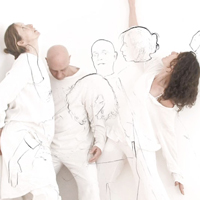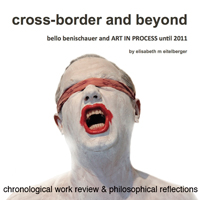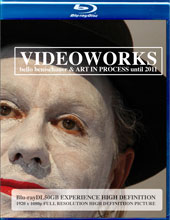PERFORMANCE LECTURE
As artists we play around with the imagination of some and the interpretation of others. Leaving enough room for contemplation, different images may occur to different persons. With this performance lecture we tried to demonstrate how to create a moment of interaction between people (of different cultural and linguistic backgrounds) as a snap-shot in time, in the context of the complex term “transculturality”. The day before our scheduled performance lecture, Bello asked some of the people onsite to get them involved in this planned participative act. We had to deliver a fifteen minutes experiment, with which we should especially react to the panel’s theme of “Theatrical disruptions”.
Performance Lecture: EXISTENCE THEATRE PRODUCTION ⓒ ART IN PROCESS
Performance Lecture during the Conference “Postdramatic Theatre as a Transcultural Theatre” University Innsbruck/Austria
Location: Bäckerei – Kulturbackstube, 14 to 16 April 2016
TEXT as spoken language CORPOREALITY the human form as such LOCATION exploring/experiencing transculturality in particular environments
“Text.Corporeality.Location” should give an insight into the Existence Theatre’s participative processes during the Panel “Theatrical disruptions with transcultural linkages”.
Thanks so much to all participants:
Marina Ortrud Hertrampf (French), Mulham Kanni (Arabic), Jan-Tage Kühling (Polish), Janine Lewis (English), Marco Russo (Italian), Linn Settimi (Italian), Ehito Terao (Japanese), Sylvia Tschörner (German) and others
What do theatrical disruptions really mean in relation to our own artistic practice apart from looking at theoretical definitions and under which premises do we use performative actions (as artistic interventions) to cause disrupting moments/situations in an otherwise organised, structured context?
We were able to perceive once more (in the realm of a Conference setting) that the triggering elements, of how such an act is seen by participants and audiences, are utterly diverse and individually different, dependent on many conditions (such as cultural/ linguistic/ historical/ political/ educational/ social/…). The lecture included just a few provoking elements to examplify, how people tend to judge quite easily (and nobody is free of that). Experience shows, how minor theatrical disruptions can be used as an effective tool to destroy existing framework conditions. It only needs a little effort to break up continued and hardened patterns, especially relevant, if we talk about transculturality, not to mention the realisation of it. Because behaviours and attitudes are strongly linked to own understandings/experiences and make it a complex and critical starting point for discussing universally working terminologies, which don’t exist. If we marginalise and classify, we fail to be able to talk about transculturality or to realise it in daily life.
In my opinion, transculturality is a very dynamic and complex term, which changes over and all the time. The ideal would be to honour the diverse “world”-concepts and to bring them together under the roof of transculturality. Once we have reached a state of general acceptance, we would be able to create a basis for the possible formation of an interdependent entity, involving all the individual concepts, which we then may call transcultural society.
With our artistic practice we try to explore the term of transcultuarlity in various ways. But on a daily basis I still preceive our society/societies as mainly multicultural. There is a strong need for a consequent and perpetual networking between the individual concepts and their people (who represent and live them) to be able to create this transcultural society, in which we may reduce the many cultural/political/social/… conflicts that exist.
Performance Lecture, Tagung “Postdramatisches Theater als transkulturelles Theater” an der Universität Innsbruck/Österreich
Ort: Bäckerei – Kulturbackstube, 14 bis 16 April 2016
TEXT als gesprochene Sprache KÖRPER die menschliche Form an sich ORT Erforschen/Erleben von Transkulturalität in bestimmten Umgebungen
„TEXT.KÖRPER.ORT“ sollte einen Einblick in partizipative Prozesse des Existence Theatre’s im Rahmen des Panels „Theatrale Störpraktiken mit transkulturellen Verweisen” geben.
Vielen Dank an alle, die sich an diesem Experiment beteiligt haben:
Marina Ortrud Hertrampf (Französisch), Mulham Kanni (Arabisch), Jan-Tage Kühling (Polnisch), Janine Lewis (Englisch), Marco Russo (Italienisch), Linn Settimi (Italienisch), Ehito Terao (Japanisch), Sylvia Tschörner (Deutsch) und andere
Als Künstler beschäftigen wir uns mit der Vorstellungskraft der einen und der Interpretation anderer. Genug Raum lassend für Reflexion, entstehen individuell unterschiedliche Bilder im Kopf. Der eigentliche Ausgangspunkt für eine Demonstration innerhalb dieser Performance Lecture bestand darin, mit Leuten (aus verschiedenen kulturellen und sprachlichen Umfeldern) einen Moment der Gleichzeitigkeit im Kontext des komplexen Begriffs Transkulturalität zu bewirken. Bello nützte den Tag vor unserer Performance Lecture um Leute vorort zu fragen ob sie sich in die performative Aktion involvieren würden. Es war geplant, ein 15 Minuten langes Experiment zu liefern, das zudem speziell auf die Thematik des Panels Theatrale Störpraktiken eingehen sollte.
Was bedeuten nun aber tatsächlich theatrale Störpraktiken aus künstlerisch, praktischer Sichtweise neben einer theoretischen Betrachtung und unter welchen Bedingungen können wir mit performativen Aktionen (als künstlerische Interventionen) tatsächlich störende Momente/Situationen in ansonsten organisierten, geordneten Kontexten erzeugen?
Es war uns möglich, einmal mehr festzustellen (im Rahmen des Tagungsumfeldes), dass auslösende Faktoren dafür, wie eine solche Aktion von TeilnehmerInnen und BetrachterInnen gesehen wird, völlig different und individuell anders sowie von vielen Umständen geprägt sind (sei dies kulturell, sprachlich, historisch beeinflusst, bildungsbedingt, sozial,…) Die Lecture sollte bewusst nur bis zu einem gewissen Grade provozieren und vor Augen führen, wie schnell und leicht man zu urteilen neigt (und niemand ist frei davon).
Die Erfahrung lehrt, dass bereits geringe theatrale Störpraktiken als effektives Mittel verwendet werden können, um existierende Rahmenbedingungen zu durchbrechen. Mit geringem Aufwand lassen sich hier fortlaufende und eingebürgerte Muster stören, speziell da einsetzbar, wenn wir beginnen uns über Transkulturalität Gedanken zu machen. Denn Verhaltensmuster und Einstellungen sind stark an das eigene Verstehen/die Erfahrungen gebunden und machen dies zu einem komplexen und kritischen Ausgangspunkt in der Diskussion universell einsetzbarer Terminologien, die in Wahrheit nicht existieren. Wenn wir marginalisieren und klassifizieren, sind wir unfähig über Transkulturalität auch nur zu sprechen, geschweige denn sie im Alltag umzusetzen.
Meiner Ansicht nach handelt es sich bei Transkulturalität um einen sehr dynamischen, komplexen und sich ständig verändernden Begriff. Weiters sehe ich das Ideal darin, die diversen „Welt“-Konzepte anzuerkennen und jene unter dem Deckmantel Transkulturalität zusammenzubringen.
Ist eine allgemeine Akzeptanz dafür erreicht, könnte mit den individuellen Konzepten eine Basis für die mögliche Formationen einer verflochtenen Einheit geschaffen werden, die in Folge tatsächlich als transkulturelle Gesellschaft gelten würde. In unseren künstlerischen Projekten versuchen wir uns ständig neu dem Begriff der Transkulturalität anzunähern. Im Alltag erlebe ich aber, dass unsere Gesellschaft(en) weiterhin stark von multikulturellen Mustern geprägt ist (sind). Damit eine tatsächliche Umsetzung in Richtung transkulturelle Gesellschaft passieren kann und Konflikte die existieren lösbar werden, sind konsequente und fortbestehende Vernetzungen unter den individuellen Konzepten und deren Menschen (die sie leben und vertreten) eine absolute Notwendigkeit.

 © EXISTENCE THEATRE ENSEMBLE
© EXISTENCE THEATRE ENSEMBLE MONOGRAPH – in progress
MONOGRAPH – in progress VIDEOWORKS BLU-RAY DL50GB
VIDEOWORKS BLU-RAY DL50GB